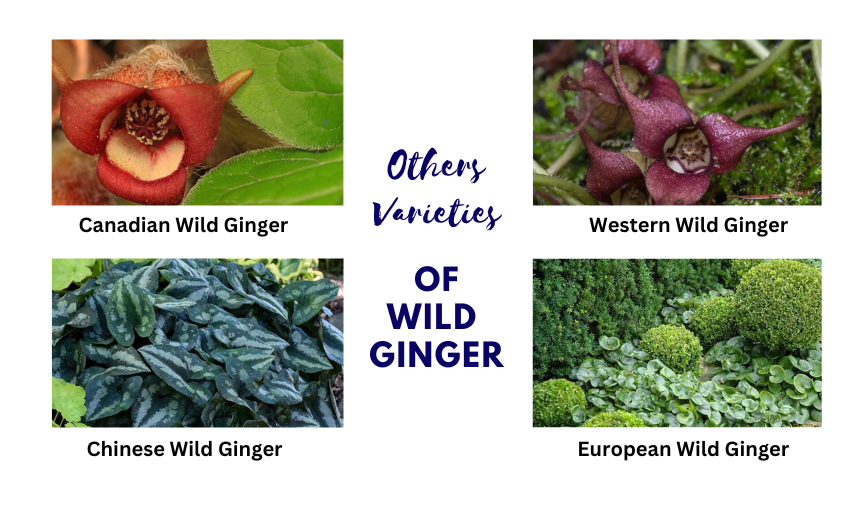Asarum caudatum, commonly known as Wild Ginger, is a perennial herbaceous plant native to Eastern North America, Australia, Europe, and Africa. In ancient times, many native North American tribes used this uncultivated ginger as a medicinal herb to treat various ailments. Common feral ginger is a natural remedy for hysteria, infections, colic, and digestive problems.
Wild Ginger root and rhizome are chewed fresh to treat colds, flu, headaches, coughs, and asthma. Asarum caudatum has many medicinal and health benefits that I will describe in detail. So, continue!
What is Wild Ginger (Asarum caudatum)?
Asarum caudatum, is a low-growing and ground-covering herb in deep shade. It typically grows about 15-30 cm tall and 30-45 cm wide—a tubular or bowl-shaped flower blooms from April to June. Asarum caudatum is quite different from the Zingiber officinale or culinary ginger. In the past days, people usually used it to flavor their foods because of its spicy aroma.
Quick facts about Asarum caudatum
| Common Name | Wild Ginger, Torch Ginger, Canadian Wild Ginger, European Wild Ginger, Chinese Ginger, Snake Root, Wild Ginger Colic Root, and broad-leaved Asarabacca |
| Scientific Name | Asarum caudatum |
| Family | Aristolochiaceae (Birthwort family) |
| Origin | Eastern North America, Australia, Europe, and Africa |
| Edible Part | Wild Ginger root and rhizome |
| Plant Type | Perennial herbaceous plant |
| Taste | Strong bitter |
| Warning | Some varieties of Wild Ginger contain poisonous leaves that may cause dermatitis in some people while handling |
Nutrition value of Wild Ginger
Asarum canadense contains the following nutrients:
- Limonene
- Geraniol
- Alpha-terpinol
- Beta-sitosterol
- Aristolochic Acid
- Bornyl Acetate
- Elemicin Methyl-eugenol
Other varieties of feral ginger plant
- Asarum caudatum
- Canadian Wild Ginger
- Chinese ginger
- Western Wild Ginger
- European Wild Ginger

Potential health benefits of Wild Ginger
Asarum canadense has many potential health benefits based on the nutrients listed above. Some medicinal uses are the following:
Reduces cholesterol level
A good amount of Beta-sitosterol is found in Asarum canadense, which helps reduce cholesterol levels in the blood. In addition to lowering bad cholesterol (LDL) and increasing HDL (good cholesterol), Beta-sitosterol can prevent coronary heart disease.
Research studies have shown that Asarum caudatum has been proven effective in reducing cholesterol levels.
Also Read: Top 10 Celebrities With High Blood Pressure
Reduces stress and anxiety
Limonene, a nutrient found in Wild Ginger, is also available in other herbaceous plants, primarily when used in essential oils such as Basil essential oil, orange aromatic oil, and Brazilian Peppertree oil. Those essential oils abundantly containing limonene are most effective in reducing anxiety and stress. According to some studies, due to the presence of limonene, feral ginger is a good anxiety fighter.
Natural pain reliever
Wild Ginger is outstanding in relieving pain. Limonene ingredients in feral ginger can ease the pain in muscle cramps, bones, and other aches. Despite the experiments that were done only on mice, some research studies showed that limonene can reduce pain in the muscles, bones, and thighs. Further studies are required so the use of Asarum canadense as a pain reliever can be trusted.
Anti-inflammatory substance
Feral Ginger contains bornyl-acetate and Geraniol. Both compounds are anti-inflammatory by nature. Due to its pungent smell, Geraniol is widely used in products such as lotions, detergents, perfumes, and soaps.
Wild Ginger has the same aroma, just like the culinary ginger you can find in your kitchen, although this is distinct from lemon or orange, which also have geraniol compounds. Geraniol and bornyl-acetate reduce inflammation when they are used in essential oils. So, Asarum caudatum works as an anti-inflammatory because it contains bornyl-acetate and Geraniol.
Act as body warmer
In ancient times, people used torch ginger as a drink to add flavor to herbal teas. They just added it to boiling water to be consumed as herbal tea. It provides many health benefits. It acts as a body warmer during the winter.
However, it is about the former days, and it is still not sure that people still use this herbal plant as tea. Although confirmed, it warms up the body and relieves colds or flu.
Natural remedy for cold and chest congestion
Canadian Wild Ginger works as a natural remedy to relieve colds, chest congestion, asthma, and coughs. it works best to sweat, boost blood circulation, and stimulate the immune system. People who suffer from the flu or cold that may cause soreness and joint pains may also use Ginger oil.
Treat upset stomach
The ginger plant is commonly used to soothe an upset stomach. A person who is experiencing nausea or vomiting can avail of the nausea-controlling properties of this European Ginger. It is the most effective herbal plant for women who have motion sickness, painful menstruation, and constipation.
Professionals recommend not to take common Wild Ginger for a longer period. Most health experts suggest that the torch ginger product should take a daily intake of one to three grams.
Treat inflammation
Asarum canadense is used in wound treatment because of having antibiotics in the roots. The chopped colic root of ginger relieves skin infection and inflammation. It not only reduces inflammation, but it also treats burns and wounds due to beta-sitosterol.
The chopped root is applied on the skin’s surface to treat inflammatory wounds or infection of sores or cuts. The colic root can be chewed to lessen the pain from dental.
Other traditional and commercial uses
- The Wild Ginger colic root is an anthelmintic tonic that works as a diuretic to relieve constipation.
- It works best to treat painful menstruation and sophomoric convulsions
- It reduces painful spasms in the bowels and stomach
- Fresh leaves are applied as a poultice for inflammation or wounds
- People use it in perfumes due to its sharp aroma
- Asarum caudatum is used to ward away insects
- Tinctures of Ginger support digestion as a carminative
- The underground stems of uncultivated ginger are used as a ginger substitute
Asarum caudatum has many medicinal, traditional, commercial, and health benefits. However, a few varieties of Asarum caudatum contain a toxic substance named aristolochic acid that can cause cancer, cell mutation, and skin inflammation. Moreover, as discussed above, some varieties of feral Ginger contain poisonous leaves that may cause dermatitis in some people. So, care should be taken while harvesting, handling, and using Wild Ginger plants.
FAQs
What does feral ginger look like?
It looks like coltsfoot leaves with soft pubescent. Its flowers are bell-shaped and located at the base of the plant.
Is Wild Ginger edible?
Feral Ginger is an herb that is not used as a kitchen spice. However, rhizome and Wild Ginger root are edible and can be chewed fresh to treat colds and chest congestion. Wild Ginger flowers and leaves are used as herbal medicine to treat various disorders.


